February 2025
North America News
The state of Oregon introduced a Permanent Administrative Order to modify its children's product safety and related reporting requirements. Such changes to the Oregon Toxic-Free Kids Act became effective on 1 January 2025.
On 22 December 2024, the Oregon Health Authority (OHA) launched a Permanent Administrative Order (PAO) (PH 119-2024) to revise the list of High Priority Chemicals of Concern for Children’s Health (HPCCCH) and the related reporting requirements as stated in the Oregon Toxic-Free Kids Act.
These updated requirements became effective on 1 January 2025.
Details about the updates are summarized below for:
The Oregon HPCCCH chemical list (10 new entries for an updated total of 83 chemicals) and,
Reporting requirements
10 New Entries for HPCCCH
| Substance name | CAS number |
| Di-(2-methoxyethyl) phthalate (DMEP) | 117-82-8 |
| Tris(2,3-dibromopropyl) phosphate (TDBPP) | 126-72-7 |
| Tri-n-butyl phosphate (TNBP) | 126-73-8 |
| Dipentyl phthalate (DPP) | 131-18-0 |
| Perfluorooctanoic acid and related substances (PFOA) | 335-67-1 |
| Tricresyl phosphate (TCP) | 1330-78-5 |
| Bis(2-ethylhexyl) tetrabromophthalate (TBPH) | 26040-51-7 |
| Bis(chloromethyl)propane-1,3-diyl tetrakis-(2-chloroethyl) bis(phosphate (V6) | 38051-10-4 |
| Isopropylated triphenyl phosphate (IPTPP) | 68937-41-7 |
| Decabromodiphenyl ethane (DBDPE) | 84852-53-9 |
Updated Reporting Requirements
- Requires manufacturers to include a children's product's brand name and product model in their reporting obligations
- Adjusts the deadline for manufacturers' reporting to 31st January of even-numbered years for the previous two-year biennial period, instead of 1st January
- Affirms that an approved or deemed approved Hazard Assessment (HA) remains valid for 3 years (For products with substitute chemicals, manufacturers must submit a new HA to stay compliant with chemical substitution rules under ORS 431A.263 after that time)
- Clarifies that selling or offering for sale products with a substitute chemical not listed in an approved HA is a violation of regulations
Manufacturers and distributors of children’s products in the state of Oregon should review the updated list and reporting requirements to ensure compliance of their products/reporting obligations.
On 31 January 2025, the U.S. Consumer Product Safety Commission published within the Federal Register, a Direct Final Rule for 16 CFR Part 1220, Safety Standard for Non-Full-Size Baby Cribs. 16 CFR Part 1220 will now reference ASTM F406-24, Standard Consumer Safety Specification for Non-Full-Size Baby Cribs/Play Yards as mandatory with modifications.
(https://www.govinfo.gov/content/pkg/FR-2025-01-31/pdf/2025-01721.pdf).
The U.S. Consumer Product Safety Commission (CPSC) published a Direct Final Rule (DFR) for 16 CFR Part 1220, Safety Standard for Non-Full-Size (NFS) Baby Cribs within the Federal Register on 31 January 2025.
16 CFR Part 1220 will now reference ASTM F406-24, Standard Consumer Safety Specification for Non-Full-Size Baby Cribs/Play Yards as mandatory with modifications, in place of the previous version, ASTM F406-22. The 2024 version of ASTM F406 contains warning language and formatting changes, additional definitions to assist in testing, additional and updated test figures, plus many other editorial changes to the standard.
This Direct Final Rule will become effective 5 April 2025 unless the CPSC receives any significant or adverse comments by 3 March 2025.
On 7 October 2024, ASTM notified the Commission that it had approved and published a newly revised version of the voluntary standard, ASTM F406–24. ASTM F406–24 contains two substantive revisions to the voluntary standard that improve the safety of NFS cribs. One modification clarifies the definitions of ‘‘play yard/non-full-size crib dependent accessory’’ and ‘‘full accessory.’’ The other revision addresses strangulation hazards by revising warning labels to expand the scope of the warning label requirements to all NFS crib accessories, and not just those intended to be removed when the NFS crib is occupied.
In summary, the substantive changes in ASTM F406–24, which is directly referenced in 16 CFR Part 1220, relate to:
NFS Crib Accessories Definitions
Strangulation Warning Labels
On 29 January 2025, the U.S. Consumer Product Safety Commission published within the Federal Register, a Direct Final Rule for 16 CFR Part 1221, Safety Standard for Play Yards. 16 CFR Part 1221 will now reference ASTM F406-24, Standard Consumer Safety Specification for Non-Full-Size Baby Cribs/Play Yards as mandatory with modifications.
(https://www.govinfo.gov/content/pkg/FR-2025-01-29/pdf/2025-01658.pdf).
The U.S. Consumer Product Safety Commission published a Direct Final Rule (DFR) for 16 CFR Part 1221, Safety Standard for Play Yards within the Federal Register on 29 January 2025.
The previous version of 16 CFR 1221 referenced ASTM F406-19, Standard Consumer Safety Specification for Non-Full-Size Baby Cribs/Play Yards as mandatory with modifications. 16 CFR Part 1221 will now reference ASTM F406-24 as mandatory with modifications, in place of the previous version.
This Direct Final Rule will become effective 5 April 2025 unless the CPSC receives any significant or adverse comments by 28 February 2025.
As listed below, updated ASTM F406–24 contains four substantive revisions that improve the safety of play yards. The revised version:
Clarifies the definitions of ‘‘play yard/non-full-size crib dependent accessory’’ and ‘‘full accessory’’
Addresses strangulation hazards by expanding the scope of the warning label requirements to all play yard accessories and not just those intended to be removed when the play yard is occupied
Adds a new requirement to limit the length of loops for cords/straps and by specifying a test to measure the perimeter of cord/ strap loops for play yards
Modifies the warning label requirements pertaining to products that have separate, removable mattresses that are not permanently fixed in place.
On 8 December 2024, the Canadian government published the revised Canada Toys Regulations, SOR/2011-17, to include sections 45, 46 and 47 for toys intended to be entered by a child. (Toys Regulations)
An update to the Canada Toys Regulations, SOR/2011-17, was published by Health Canada on 8 December 2024 to include § 45, 46, and 47 for toys intended to be entered by a child. These updated sections, as directly referenced from the specified regulation, are referenced below:
Toys Intended to be Entered by a Child
Exception § 45 Sections 46 and 47 do not apply to a tent as defined in subsection 1(1) of the Tents Regulations, SOR/2024-217.
Requirements and testing
§ 46 (1) A toy intended to be entered by a child must be tested in accordance with subclauses 5.1 and 5.4 of the International Organization for Standardization, standard ISO 8124–2 entitled Safety of toys — Part 2: Flammability, as amended from time to time, and meet the requirements set out in subclause 4.4 of that standard, excluding the requirement that the toy and its packaging be permanently marked with a statement if the rate of the spread of the flame of the test sample is from 10 mm/s to 30 mm/s.
Compliance period
(2) Despite subsection (1), a toy intended to be entered by a child that meets a requirement referred to in that subsection, as it read immediately before the day on which a new version of standard ISO 8124-2 is published, may continue to meet that requirement:
(a) in the case of the manufacture or import of the toy intended to be entered by a child, for a period of 180 days that begins on that day; and
(b) in the case of the advertisement or sale of the toy intended to be entered by a child, for a period of 365 days that begins on that day.
Warning
§ 47 (1) The outer surface of a toy intended to be entered by a child must have a permanent label containing the following warning or its equivalent, in bold upper-case letters at least 3 mm in height and in both official languages:
“WARNING: KEEP AWAY FROM HEAT AND OPEN FLAME / MISE EN GARDE : TENIR LOIN DES SOURCES DE CHALEUR ET DES FLAMMES NUES”.
Alert symbol
(2) The permanent label must contain the following alert symbol, at least 6 mm in height, immediately before the warning:
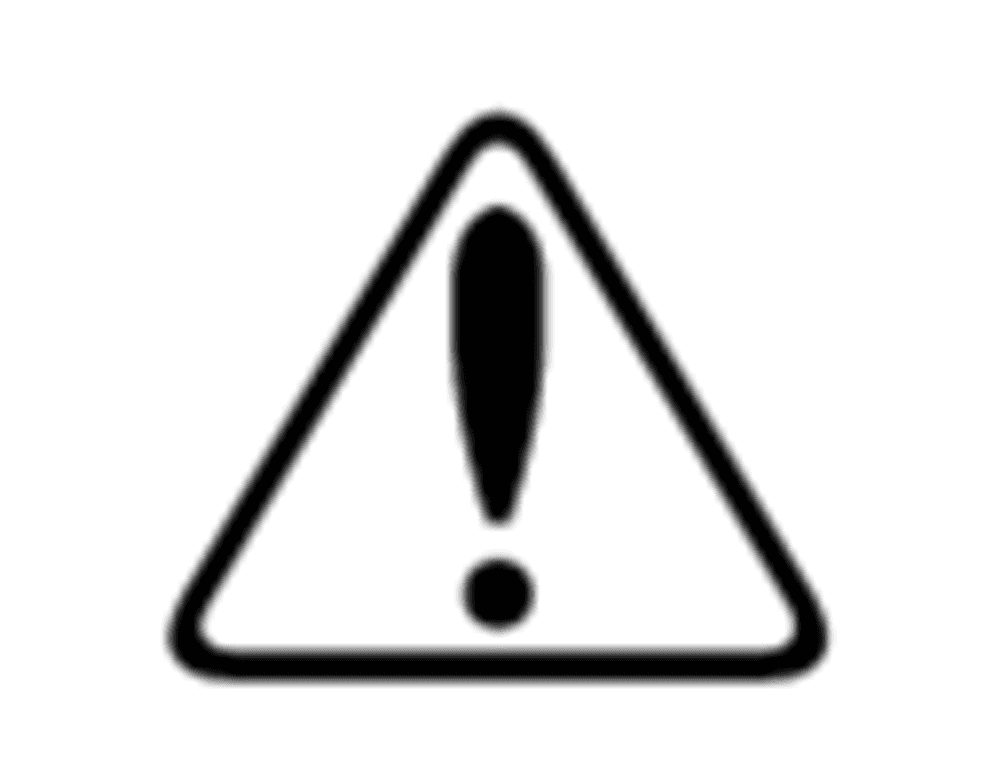
The symbol is represented by an equilateral triangle. An exclamation mark is shown centered inside the triangle.
Additional requirement
(3) The warning and the alert symbol must be affixed to the toy intended to be entered by a child in such a manner that they are legible and clearly visible throughout the life of the toy.
In the US, when hazards are identified in consumer products, they will be recalled and published in the Consumer Product Safety Commission (CPSC) Recent Recalls on the CPSC website, which is updated daily. The US recalls from 01 January 2025 to 31 January 2025 are summarized below:
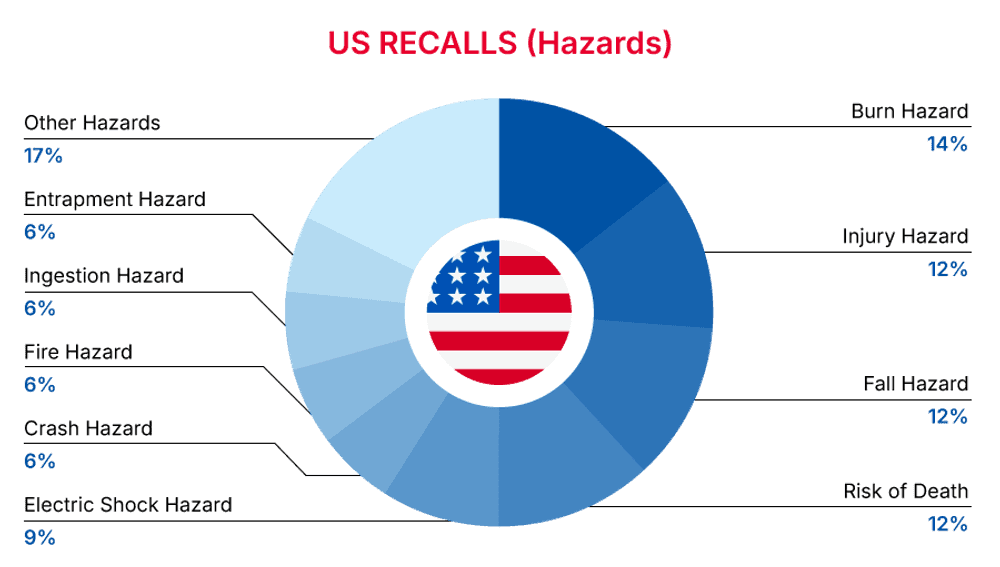
| Hazards | Frequency |
| Burn Hazard | 5 |
| Injury Hazard | 4 |
| Fall Hazard | 4 |
| Risk of Death | 4 |
| Electric Shock Hazard | 3 |
| Crash Hazard | 2 |
| Fire Hazard | 2 |
| Ingestion Hazard | 2 |
| Entrapment Hazard | 2 |
| Other Hazards* | 6 |
*Other Hazards include Lead Poisoning Hazard, Strangulation Hazard, Laceration Hazard, Choking Hazard, Tip-Over Hazard and Poisoning Hazard with a frequency of less than 2.

| Product Categories | Frequency |
| Home Electrical Appliances | 5 |
| Furniture | 5 |
| Fabric / Textile / Garment / Home Textile | 3 |
| Protective Equipment | 2 |
| Jewelry | 1 |
| Bodycare / Cosmetics | 1 |
| Electrical Appliances | 1 |
| Toys and Childcare Products | 1 |
| Food Contact Material | 1 |
| Tools and Hardware | 1 |
| Sporting Goods / Equipment | 1 |
For a complete list click here
In Canada, when hazards are identified in consumer products, they will be recalled and published in the Recalls and Safety Alerts Database on the Health Canada website, which is updated daily. The Canada recalls from 01 January 2025 to 31 January 2025 are summarized below:
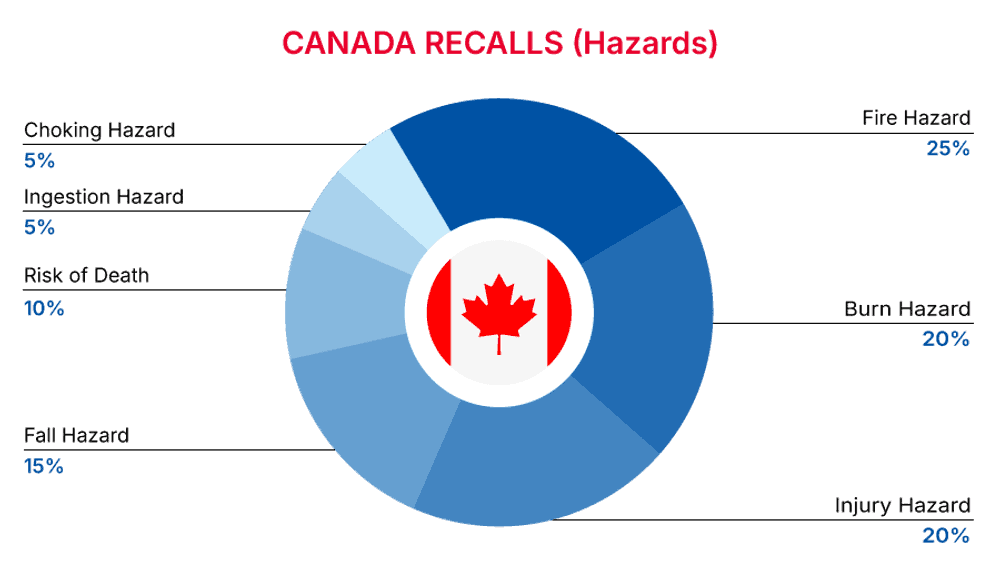
| Hazards | Frequency |
| Fire Hazard | 5 |
| Burn Hazard | 4 |
| Injury Hazard | 4 |
| Fall Hazard | 3 |
| Risk of Death | 2 |
| Ingestion Hazard | 1 |
| Choking Hazard | 1 |

| Product Categories | Frequency |
| Electrical Appliances | 4 |
| Home Electrical Appliances | 2 |
| Chemicals | 1 |
| Fabric / Textile / Garment / Home Textile | 1 |
| Toys and Childcare Products | 1 |
| Food Contact Material | 1 |
| Tools and Hardware | 1 |
| Furniture | 1 |
| Sporting Goods / Equipment | 1 |
For a complete list click here
Europe News
Newly implemented regulation (EU) 2025/40 harmonizes national measures on packaging and packaging waste and signals a significant shift in packaging design, usage, and recycling practices across the European Union.
On 11 February 2025, the Packaging and Packaging Waste Regulation (PPWR) (EU) 2025/40 became effective.
This regulation signals a significant shift in packaging design, usage, and recycling practices across the European Union (EU). It applies to all packaging, regardless of the material used, and to all packaging waste, whether such packaging or such packaging waste originates from, or is used in, industry, other manufacturing, retail or distribution, offices, services or households.
The PPWR requires that substances of concern as constituents of packaging material or of packaging components be minimized with the objective to ensure that packaging, as well as materials recycled from packaging, do not have any adverse effect on human health or the environment throughout their life cycle.
Details as below:
Relationship with related regulations:
amends Regulation (EU) 2019/1020 on market surveillance and compliance of products
repeals Directive 94/62/EC on packaging and packaging waste (PPSD)
applies without prejudice to Directive 2008/98/EC on waste and repealing certain Directives; however, where this Regulation conflicts with Directive 2008/68/EC, Directive 2008/68/EC shall prevail
2. Requirements for substances in packaging:
sum of Lead, Cadmium, Mercury and Chromium (VI) ≤100 mg/kg
Note: where this Regulation conflicts with Annex XVII to Regulation (EC) No 1907/2006 or Regulation (EC) No 1935/2004, Regulation (EC) No 1907/2006 and Regulation (EC) No 1935/2004 shall prevail
per- and polyfluoroalkyl substances (PFASs) are prohibited in food-contact packaging from 12 August 2026 with established requirements as follows:
(a.) < 25 ppb for any individual non-polymeric PFAS
(b.) < 250 ppb for the sum of PFAS
(c.) < 50 ppm for PFASs (including polymeric PFAS)
While full enforcement begins on 12 August 2026, businesses are urged to act swiftly to meet compliance requirements and strategize for the impending new regulations.
In Europe, when hazards are identified in non-food consumer products, the products will be recalled and published in the Safety Gate system, which is updated weekly. The European recalls from 01 January 2025 to 31 January 2025 are summarized below:
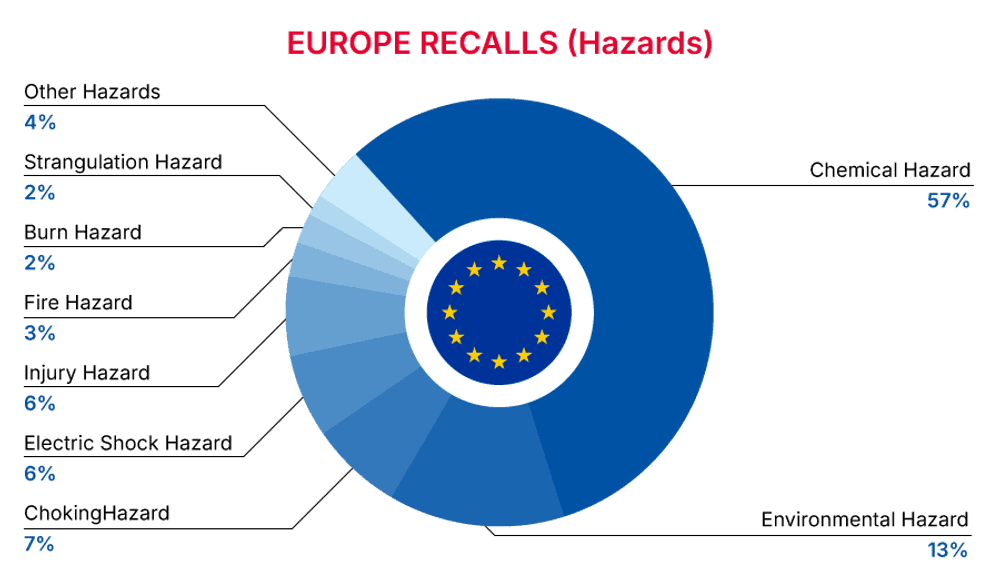
| Hazards | Frequency |
| Chemical Hazard | 317 |
| Environmental Hazard | 74 |
| Choking Hazard | 39 |
| Electric Shock Hazard | 35 |
| Injury Hazard | 34 |
| Fire Hazard | 14 |
| Burn Hazard | 13 |
| Strangulation Hazard | 8 |
| Other Hazards* | 23 |
*Other Hazards include Damage to Sight, Damage to Hearing, Entrapment Hazard, Suffocation Hazard, Drowning Hazard, Cut Hazard and Health Risk Hazard with a frequency of less than 3.

| Product Categories | Frequency |
| Bodycare / Cosmetics | 219 |
| Electrical Appliances | 83 |
| Toys and Childcare Products | 80 |
| Chemicals | 29 |
| Home Electrical Appliances | 17 |
| Sporting Goods / Equipment | 13 |
| Tools and Hardware | 11 |
| Fabric / Textile / Garment / Home Textile | 11 |
| Other Categories* | 49 |
*Other Categories include Household Items, Jewelry, Outdoor Living Items, Computer / Audio / Video / Other Electronics & Accessories, Footwear, Food Contact Material, Stationery, Machinery and Protective Equipment with a frequency of less than 11.
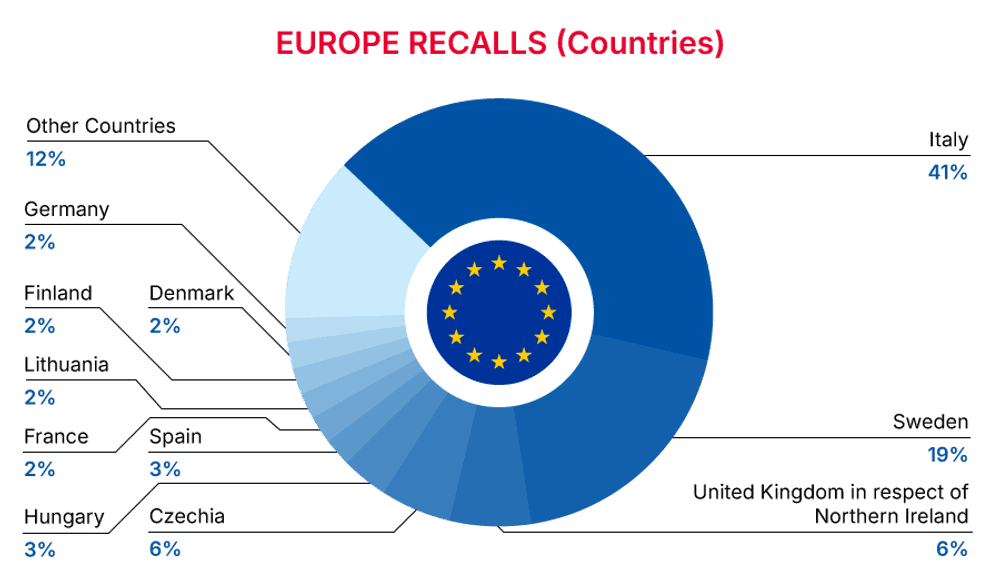
| Notifying Country | Frequency |
| Italy | 211 |
| Sweden | 98 |
| United Kingdom in respect of Northern Ireland | 32 |
| Czechia | 28 |
| Hungary | 17 |
| Spain | 12 |
| France | 11 |
| Germany | 10 |
| Lithuania | 10 |
| Finland | 10 |
| Denmark | 10 |
| Other Countries* | 63 |
*Other Countries include Belgium, Estonia, Ireland, Poland, Malta, Slovakia, The Netherlands, Cyprus, Austria, Croatia, Bulgaria, Romania and Slovenia with a frequency of less than 9.
For a complete list click here
China News
In China, when hazards are identified in consumer products, they will be recalled and published in the SAMR Defective Product Administrative Centre, which is updated daily. The China recalls from 01 January 2025 to 31 January 2025 are summarized below:
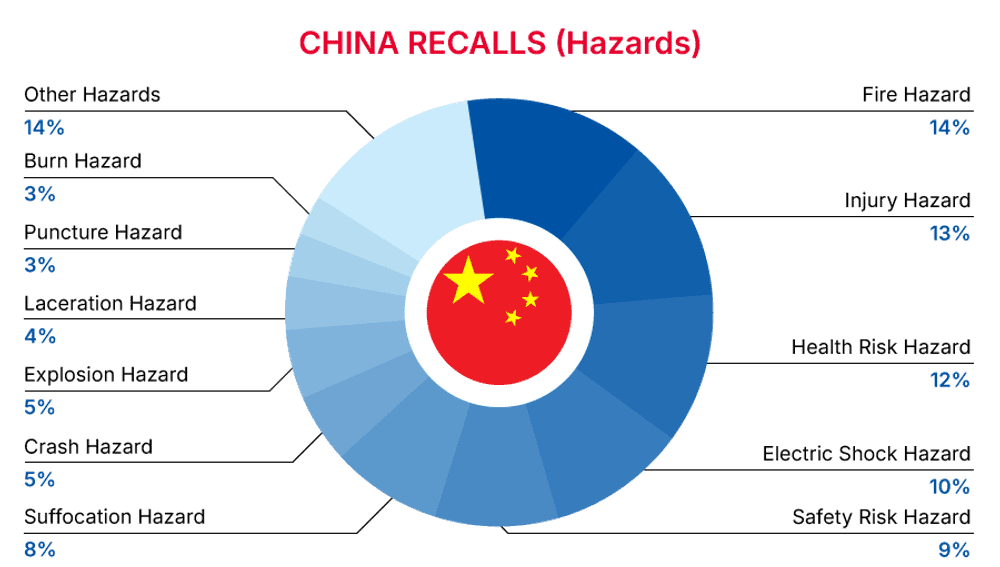
| Hazards | Frequency |
| Fire Hazard | 13 |
| Injury Hazard | 12 |
| Health Risk Hazard | 11 |
| Electric Shock Hazard | 10 |
| Safety Risk Hazard | 9 |
| Suffocation Hazard | 8 |
| Crash Hazard | 5 |
| Explosion Hazard | 5 |
| Laceration Hazard | 4 |
| Puncture Hazard | 3 |
| Burn Hazard | 3 |
| Other Hazards* | 13 |
*Other Hazards include Eye Irritation Risk, Skin Irritation Risk, Chemical Hazard, Entanglement Hazard, Swallowing Risk, Strangulation Hazard, Choking Hazard and Fall Hazard with a frequency of less than 3.

| Product Categories | Frequency |
| Toys and Childcare Products | 12 |
| Sporting Goods / Equipment | 10 |
| Furniture | 8 |
| Home Electrical Appliances | 7 |
| Fabric / Textile / Garment / Home Textile | 7 |
| Stationery | 6 |
| Electrical Appliances | 5 |
| Travel Items | 4 |
| Food Contact Material | 4 |
| Chemicals | 3 |
| Other Categories* | 3 |
*Other Categories include Protective Equipment and Footwear with a frequency of less than 3.
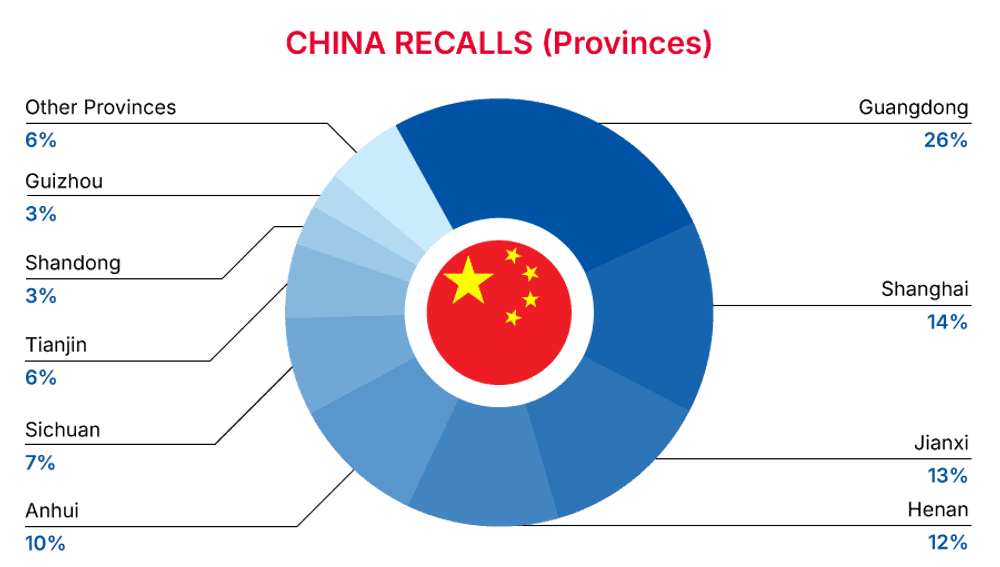
| Provinces | Frequency |
| Guangdong | 18 |
| Shanghai | 10 |
| Jiangxi | 9 |
| Henan | 8 |
| Anhui | 7 |
| Sichuan | 5 |
| Tianjin | 4 |
| Shandong | 2 |
| Guizhou | 2 |
| Other Provinces* | 4 |
*Other Provinces include Heilongjiang, Jiangsu, Hubei and Beijing with a frequency of less than 2.
For a complete list click here
Australia/New Zealand News
In Australia, when hazards are identified in consumer products, they will be recalled and published in the Recalls and Safety Alerts Database on the Australian Competition & Consumer Commission website, which is updated daily. The Australia recalls from 01 January 2025 to 31 January 2025 are summarized below:

| Hazards | Frequency |
| Risk of Death | 11 |
| Burn Hazard | 7 |
| Choking Hazard | 6 |
| Fire Hazard | 5 |
| Injury Hazard | 5 |
| Drowning Hazard | 3 |
| Swallowing Risk | 3 |
| Cut Hazard | 1 |
| Explosion Hazard | 1 |
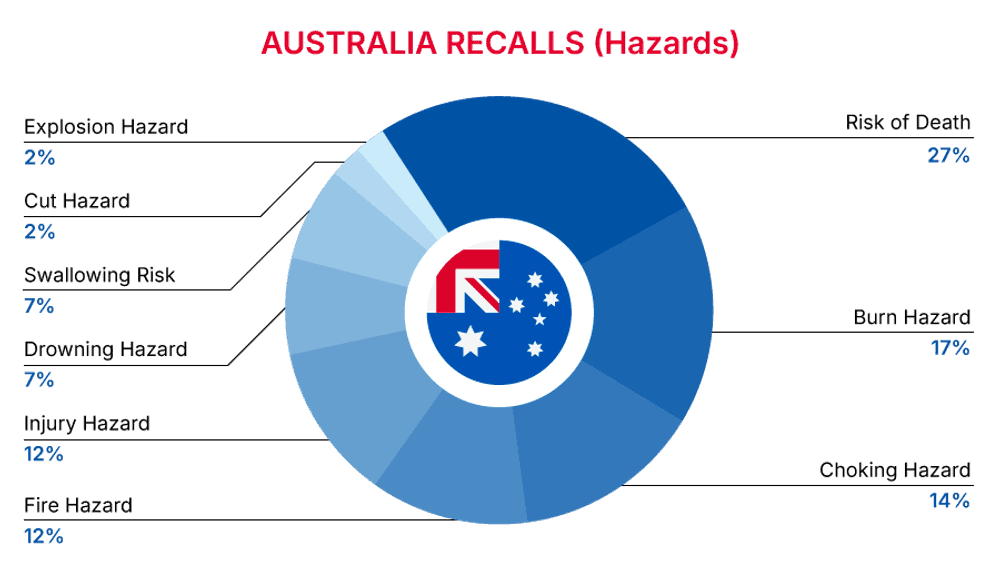
| Product Categories | Frequency |
| Outdoor Living Items | 5 |
| Toys and Childcare Products | 4 |
| Electrical Appliances | 3 |
| Home Electrical Appliances | 2 |
| Food Contact Material | 2 |
| Tools and Hardware | 1 |
| Furniture | 1 |
For a complete list click here
Subscribe to our Regulatory Updates
Unsubscribe at any time. Read our privacy policy.